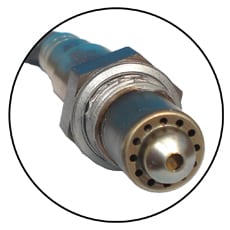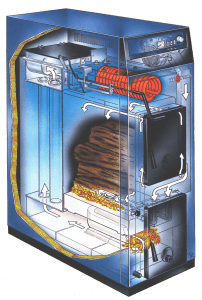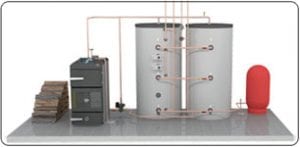The Modern Wood Boiler
Thinking about Modern, Renewable Heating Systems


Modern Wood gasification boilers have been popular in the United States since the 1980s. Gasification of wood takes place when the wood is heated in a zero or near zero oxygen environment. Volatile gasses leave the wood but are not burned until they are introduced to a hotter, oxygen-rich combustion chamber. Many boilers described as gasification boilers such as the Fröling S3 Turbo and Effecta Smart use the principal of gasification, where wood gasses are driven from the wood with relatively low oxygen levels. The resulting gasses are burned in a lower chamber that is isolated from temperature quenching water. The hot gasses that result from combustion are then exchanged with boiler water before exiting into the chimney. A better description of the process may be "two-stage combustion", as wood gasses are created in a firebox and then burned completely in a specially designed chamber that is typically smaller, hotter, and very turbulent. Regardless of what it is named, the process is tried, true, and time tested. Most high efficiency and low emission wood boilers utilize gasification, especially those that are EPA legal for installation in residences. See the EPA certified boiler list here.

Advancements in wood boilers have dramatically reduced the labor involved with operation, primarily due to dramatic reductions in creosote formation and reduced wood consumption. The Fröling S3 and Effecta Smart wood boilers normally produce no soot in the heat exchange tubes or in the chimney. Eliminating flammable creosote from these areas makes chimney fires an old-fashioned problem. Not only that, but creosote insulates heat exchange surfaces, so eliminating it makes wood boilers more efficient. What about indoor air pollution? Today's homes are tighter, which means that smoke spilling out of a boiler door is bad news. Even when loading an outdoor boiler, the operator is likely to get a face full of smoke when the boiler door is open. As mentioned previously, one large improvement with new two-stage wood boilers is that they use induced draft. Induced draft means that a suction fan is mounted on the exhaust pipe of the boiler. The fan is operating not only during the regular burn but also during the lighting and loading process. Between-batch burning and induced draft, practically no smoke exits the boiler door.
Some retailers and manufacturers in the wood boiler industry are attempting to cling to dirty, inefficient technologies by claiming an exemption for "commercial use" or by trading in fear of modern technology. Some sell coal boilers, which are EPA exempt but include a wood length within the coal boiler specifications. We've seen it said by these same organizations that modern, two-stage technology is too complicated. They say computers, sensors, and blowers are trouble. It's a shame. Maybe they just haven't tried the boilers we sell. Meanwhile, these companies continue to create a black eye for wood burning by selling equipment that makes neighbors ill and regulators angry. In particular, outdoor boilers have been a target of regulators. Outdoor wood boiler technology encourages dirty, smoldering fires and the use of cold, wet wood. There's a well known company that lists as a safety feature, "USE UN-SPLIT WOOD up to 50 inches." Outdoor wood boilers utilize short chimneys. Tall chimneys would likely completely fill with soot and stop many outdoor wood boilers from operating. The other dirty secret about outdoor wood boilers is that they have to be loaded outdoors in winter. Our customers tell us over and over how much they enjoy being able to load their boilers while in stocking feet in the comfort of their homes.
It is well known that a fire burns best when it burns continuously. Even oil and gas fires are dirtiest when started and extinguished. Quenching a wood fire by decreasing combustion air is usually a recipe for clouds of smoke. Some modern wood boilers can decrease output without making excessive smoke. Using active combustion control, the Fröling S3 Turbo wood boiler can modulate to 50% of its rated output. Pellet boilers can take this a step further by adding smaller and smaller quantities of fuel. However, even the Froling S3 Turbo modulating wood boiler cannot reduce its output to less than 1/2 of rated output without becoming too smoky.
Because wood burns best when burned continuously, but most buildings cannot take the full output of the boiler, insulated water tanks are used as thermal storage for excess heat. The heat stored in the water can be used for many hours after the fire has burned out. Most of our customers report visiting their boilers no more than once every 12 hours in the coldest weather. When the weather gets warmer, visits to the boiler become less common. If just a little heat is needed, the heat in the storage tanks often will last 2 days or more. Some of our customers go a week at a time between loads when heating domestic hot water in the summer. This method of continuous burn and heat storage is very successful in reducing emissions. The boilers burn in their cleanest mode of operation and then their heat is available for several hours with zero emissions.

For decades, heating systems in the U.S. have been designed around 180 degrees F supply water. For that reason, many existing heating systems have just enough surface area to dissipate the designed heat output when supplied at 180 F. There is some cushion because heat output is usually designed based on the theoretical coldest day. On warmer days, water may not have to be 180 F to provide adequate heat. The trouble is that modern appliances, whether wood burning, gas burning or heat pump technology, work better with low-temperature heat distribution. For instance, even new gas boilers often advertise efficiency in the low 90% range. Did you know that unless a heating system is using low-temperature distribution, with a high-efficiency gas boiler that the actual efficiency of that same gas boiler is about 10% lower? The 10% difference is caused by condensing the exhaust gasses, which rarely takes place with baseboard heat or forced hot air supplied with 180-degree water.
So, if low-temperature heat distribution is a benefit, what is required to upgrade from the existing high-temperature heat? By simply increasing the surface area of exchange surfaces, such as by adding more baseboard, or retrofitting high output panel radiators in ideal locations, lower water temperature can be used. Low-temperature distribution is the future of central heat. Just as high flush toilets, unrestricted shower heads, and incandescent light bulbs should be replaced, so too high-temperature heating should be replaced.
In order to provide more information about modern wood boilers using batch burning, we've assembled a list of other common considerations:
- Expense: While installing a batch burning "gasification" or "two-stage" modern wood boiler may seem expensive, the combination of boiler and thermal storage tanks enables much better utilization of the boiler. The wood boiler can be used 12 months of the year. One Achilles heel of wood boilers is corrosion from creosote inside the firebox. Many boiler manufacturers try to cure this problem by using stainless steel. Stainless steel is a troublesome boiler material because it is brittle and doesn't resist heating and cooling cycles as well as carbon steel. Stainless steel is also a less effective material for heat transfer. Proper operation of wood boilers with thermal storage eliminates corrosive firebox creosote so your investment will last decades. Furthermore, the boiler can be built with long-lasting carbon steel, a time-proven material (Ever heard of boilerplate??? Hint: It isn't stainless). It is hard to put a price on convenience and safety, but they are no doubt worth plenty. As for the cost of heat storage tanks, Tarm Biomass sizes heat storage tanks based on the output of the boiler. Generally speaking, most customers use between 400 and 800 gallons of thermal storage. For more information take a look at our wood boiler installation guide or please call Tarm Biomass to request pricing.
- Heating Systems: As mentioned above, modern boilers and thermal storage work well with all types of heating systems. When heat storage tanks are depleted, heat goes straight from the boiler to the house. Water-based "hydronic heat" is highly flexible. Many of our customers heat domestic hot water and multiple and various types of heating zones from radiant heat to forced hot air. Tarm Biomass does not sell distribution components, but we are happy to help you consider how to integrate a modern wood boiler in your heating system.
- Practicality: Our customers enjoy not worrying about chimney fires or upsetting a spouse by filling the house and/or yard with smoke. Visiting the boiler less frequently and tending the fire in stocking feet is a luxury. With thermal storage tanks and oxygen controlled combustion, there is no tinkering with air controls, prodding with pokers, or climbing on the roof to clean the chimney. Burning less wood means preparing less wood. Many of our customers report cutting their wood consumption in half compared to outdoor wood boilers. Modern wood boilers use wood that is practically sized so that labor is reduced, but all family members can handle it.
- Electrical compatibility: The Fröling S3 operates with 240VAC 60 Hz power, which is what most electric clothes driers and ovens operate with. The Fröling uses about 1600 Watt-hours per day (winter operation). The Effecta Smart operates on 120 VAC 60 Hz power and uses about 800 Watt-hours per day (winter operation).
- Technical support: Tarm Biomass sets the industry standard for technical support. Our technical support team has worked here on average over 15 years per person. We have handled thousands of calls for support in the last 25 years of operation. We know our products inside out and we carry thousands of spare parts right here in New Hampshire, from the critical part to the oddball you'd never guess we have. We are still supporting operating wood boilers over 40 years old. Who else can claim that?
- Modern wood burning technology: The Fröling S3 and Effecta Smart modern wood boilers set the standard for quality and reliability. Just as your modern car is more likely to start up on a cold morning than a 40-year-old car, modern wood burning technology makes the boiler burn better, cleaner, and use less wood. Intelligent feedback provides useful information about operating hours, boiler temperature, storage tank temperature, and will also help troubleshoot.
- Thermal Efficiency versus Combustion Efficiency: Thermal efficiency is a measure, expressed as a percentage of the amount of heat available in fuel vs. the amount of heat delivered to supply water that will go to heat the building. Combustion efficiency is a measure, expressed as a percentage, of how much energy is released from the fuel compared to how much energy was available in the fuel. In other words, combustion efficiency is a measure of how much heat is produced but has nothing to do with capturing the heat for useful purposes. Manufacturers of outdoor wood boilers and old fashioned combustion designs often do not publish third-party efficiency data. Boilers sold by Tarm Biomass are tested and are EPA Certified. We only publish honest efficiency data.
- Lifestyle: Modern wood boilers provide energy independence, savings and the additional peace of mind that comes from knowing that the equipment is safe not only for your family but also for your neighbors. While we're no strangers to the rigors of firewood preparation, we certainly don't want to be slaves to our boilers. The intuitive Fröling operating control knows what to do when the door is opened. The Effecta Smart uses a one-touch control. There is no tinkering with the fire. Just start a fire and walk away. Walk away and don't come back for 12-24 hours; even in winter.
- Durability: Tarm Biomass supplies modern wood boilers that are meant to work hard. Our suppliers have research and development experience that can only come from selling tens of thousands of boilers and programs of continuous improvement. Manufacturing facilities are ISO 9001 quality certified. We are not against U.S.A. made products. However, it is clear that when it comes to wood boilers, Europeans have a massive advantage due to years of state-funded regulation and development and a strong culture of wood burning. Robust competition in Europe allows only the best products to rise to the top.
Honesty, Integrity, Skill, Knowledge, and Experience: The wood burning industry, unfortunately, has a history of false and misleading claims. There is still plenty of snake oil going around. At Tarm Biomass we won't always tell you what you want to hear, but we will tell the truth. Our products are tested, listed, and proven in the field. Tarm Biomass is respected and trusted by regulators and customers alike. Chat us up sometime. We look forward to it


2 thoughts on “Modern Wood Boilers – The Benefits of Batch Burning”
I have a Garn boiler. They r built in Minnesota. I bought it used. It was built in 1985 n has a 500 gallon capacity. It uses ceramic lined tube behind firebox. Question.; if we want to go away in winter and dont want to drain system what kind of tank heater would u recommend to put in tank to keep temp at say 80 degrees.we would keep pump running to circulate water through our lap gas furnace. The boiler is 6 feet long 5 foot in diameter. Thanks
Sorry, I have no idea. I would give Garn a call.